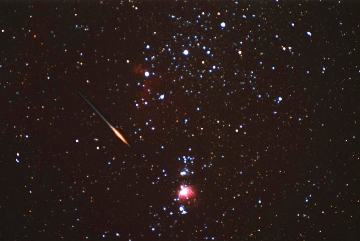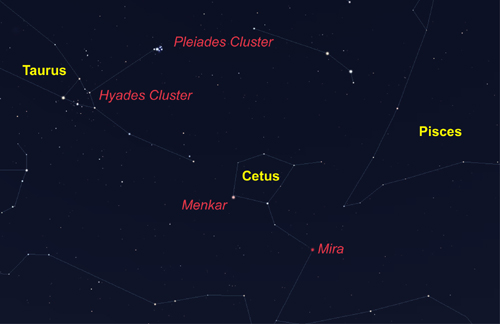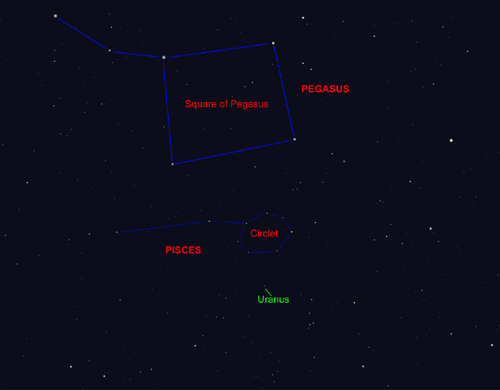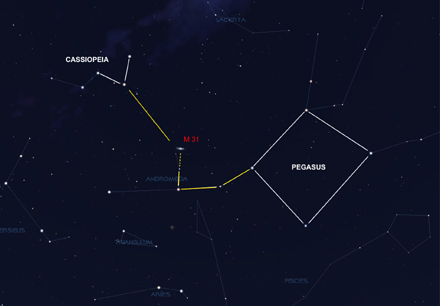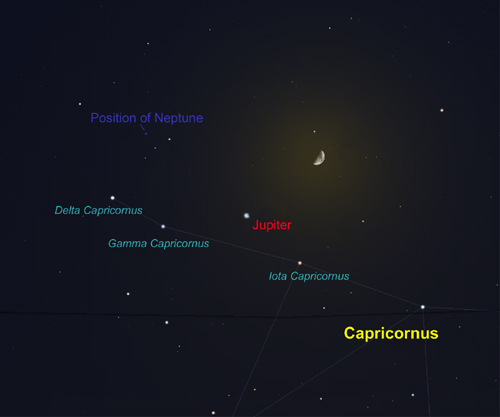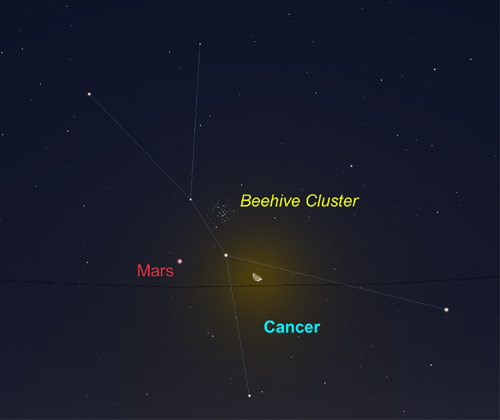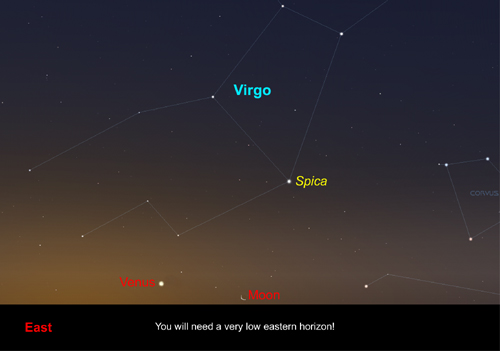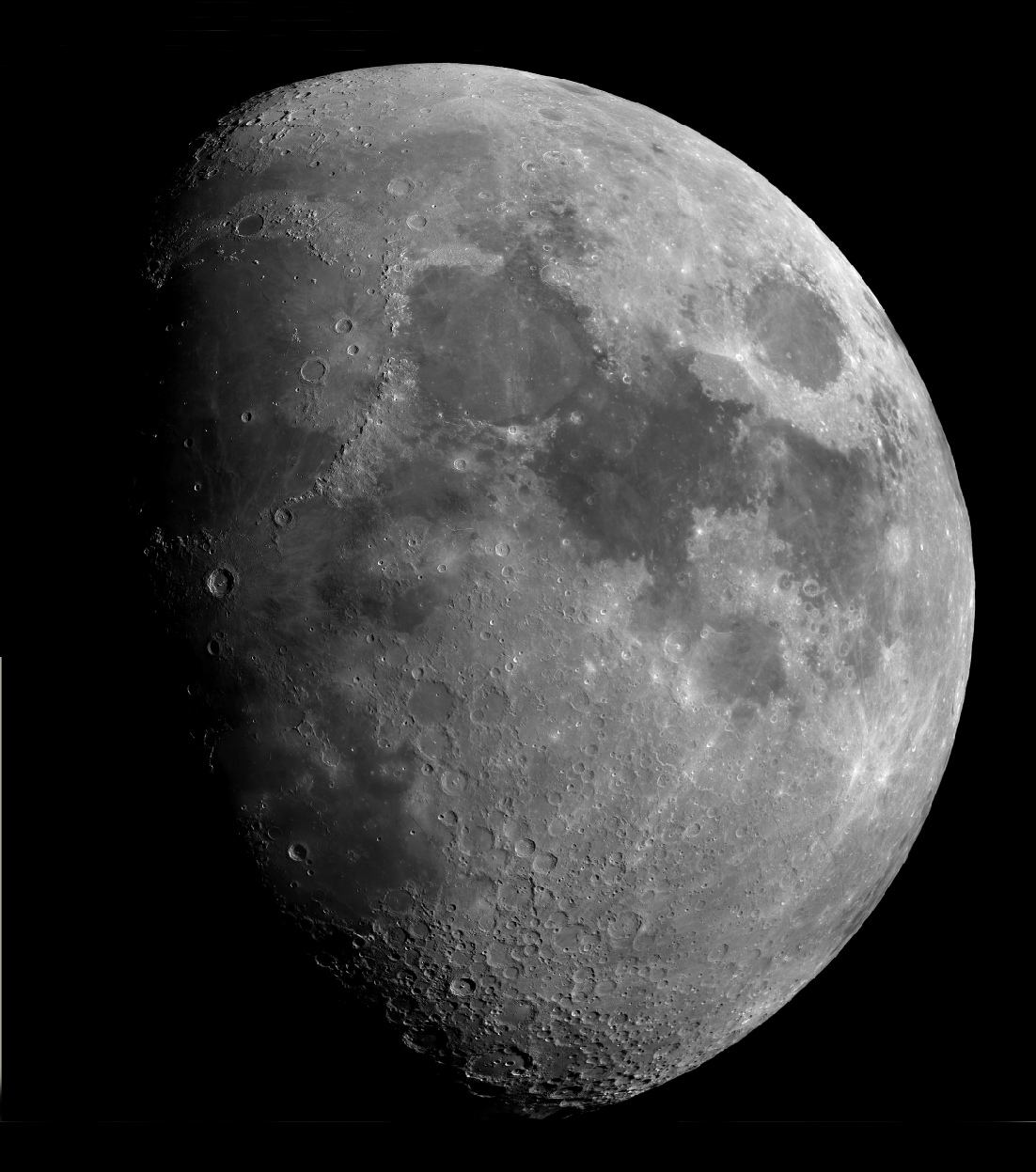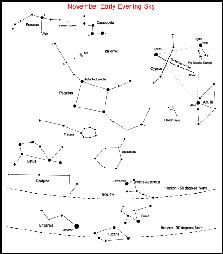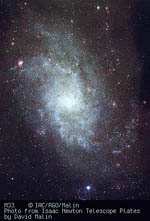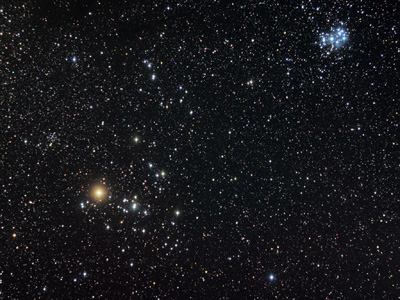The Night Sky November 2009
Compiled by Ian Morison
This page, updated monthly, will let you know some of the things that you can look out for in the night sky. It lists the phases of the Moon, where you will see the naked-eye planets and describes some of the prominent constellations in the night sky during the month.
Image of the Month
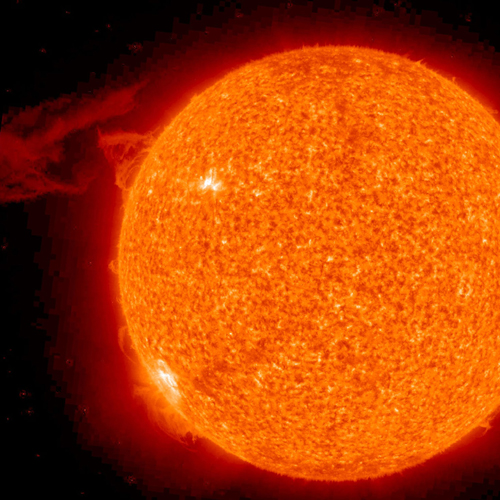
Is the Sun Waking up?
Image:STEREO project, NASA
This image by taken by the STEREO A spacecraft shows a giant prominence that occured on the 26-27th September. The very quite nature of the Sun over the past two years - the most prolonged solar minima for a very long time - has made such occurances uncommon. Some sunspot groups do now seem to be appearing on the Sun's surface as shown in the image below taken by the SOHO spacecraft on the 26th October 2009. Perhaps the next solar cycle has really begun?
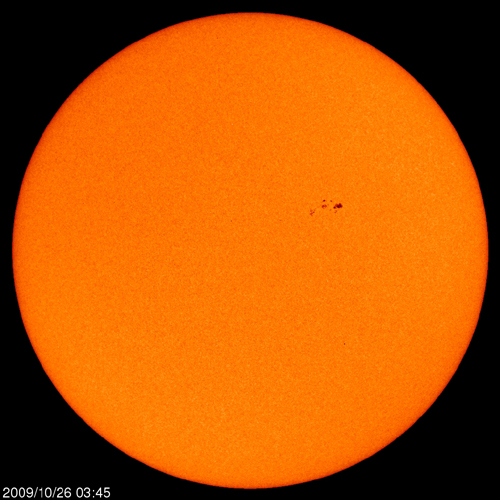 Sunspot Group on October 26th
Sunspot Group on October 26th
Image:SOHO, NASA
Highlights of the Month
November17th/18th: The Leonid Meteor Shower
Every year, on November 17th and 18th, the Earth passed close to the trails of cometry debris from Comet Temple-Tuttle which produce the annual Leonid Meteor shower. The wonderful image shows one of the 2001 Leonids burning up in the atmosphere as it crossed the constellation of Orion. The really good thing this year is that this corresponds to New Moon, so there will be no moonlight to hide the fainter meteors! The dust particles that are swept up by the Earth are released as Comet Temple-Tuttle rounds the Sun every 33 years. As implied by the name, the radiant of the shower - from where the meteors appear to radiate from - lies within the head or Sickel of the constellation Leo the Lion. The peak activity is expected to be around 21:50 on the night of the 17th when the rate might easily exceed 100 metors per hour. If clear this is really well worth looking out for!
November: See Mira at its brightest
Cetus, the Whale, lies down to the right of Taurus and is not that prominent, nor are there many interesting objects within it. It does, however contain a very interesting variable star that was called Mira - meaning "wonderful" - so named by Johannes Helvelius in 1662. It was discovered in 1596 by David Fabricus and was one of the first variable stars to be discovered. Helvelius found that it has a 332 day cycle during which time it varies in brightness from +9.3 (when binoculars will be needed to see it!) up to ~ +3. However, the peak magnitude does vary significantly and in February 2007 it almost reached magnitude +2. So during its maximum this month (peak brighness is on November 18th) it could exceed the brightness of Menkar which has a magnitude of +2.5. This must be worth a look around 11 pm mid November!
Around new Moon ~16th November: Find Uranus.
Uranus was at opposition on September 17th and is still well placed to observe in the late evening. With a magnitude of +5.7 it lies just below the circlet of Pisces which itself lies below the square of Pegasus. The chart show its position mid month as it moves down and to the right towards the star Beta Aquari. Under very dark skies it would just be visible to the unaided eye, but binoculars will probably be need to see it from our light polluted skies.
Find M31 - The Andromeda Galaxy
In the evening, the galaxy M31 in Andromeda is visible in the south. The chart provides two ways of finding it:
1) Find the square of Pegasus. Start at the top left star of the square - Alpha Andromedae - and move two stars to the left and up a bit. Then turn 90 degrees to the right, move up to one reasonably bright star and continue a similar distance in the same direction. You should easily spot M31 with binoculars and, if there is a dark sky, you can even see it with your unaided eye. The photons that are falling on your retina left Andromeda well over two million years ago!
2) You can also find M31 by following the "arrow" made by the three rightmost bright stars of Cassiopeia down to the lower right as shown on the chart. Good Hunting!
November 23rd: Jupiter, Neptune and the 23 day old Moon
At about 7-8pm on the 23rd November,the Moon, a day before first quarter, is just over 2 degrees up to the right of Jupiter. 4 degrees to the upper left of Jupiter is Neptune at 7.9th magnitude. It lies just to the left of a line of three stars, 42 Cap, the upper, at 5.1 magnitude, 44 and 45 Cap, below at ~ 6th magnitude. A pair of 8 x 40 binoculars should be able to encompass the field of view. Neptune will be easier to spot on the days before and after when the Moon is not so close in the sky - it will be just above Jupiter next month - one of that month's highlights!
8th November, Midnight: The last quarter Moon Moon passes below the Beehive cluster - with Mars to its left.
A nice view of the last quarter Moon close to Mars will be seen around midnight on the 8th November. With binoculars, you should be able to see the stars of the Beehive Cluster as well!
Dawn - November 15th: A very thin waning crescent Moon close to Venus
If it is clear on the morning of the 15th November and you have a very clear and low eastern horizon, you will have a chance to spot a waning crescent moon which is just 2% illuminated. Binoculars will almost certainly be required - but do not use them after the Sun has risen!
Observe the International Space Station

The International Space Station and Jules Verne passing behind the Lovell Telescope on April 1st 2008.
Image by Andrew Greenwood
Use the link below to find when the space station will be visible in the next few days. In general, the space station can be seen either in the hour or so before dawn or the hour or so after sunset - this is because it is dark and yet the Sun is not too far below the horizon so that it can light up the space station. As the orbit only just gets up the the latitude of the UK it will usually be seen to the south, and is only visible for a minute or so at each sighting. Note that as it is in low-earth orbit the sighting details vary quite considerably across the UK. The NASA website linked to below gives details for several cities in the UK. (Across the world too for foreign visitors to this web page.)
Note: I observed the ISS three times recently and was amazed as to how bright it has become.
Find details of sighting possibilities from your location from: Location Index
See where the space station is now: Current Position
The Moon

The Moon at 3rd Quarter. Image, by Ian Morison, taken with a 150mm Maksutov-Newtonian and Canon G7.
Just below the crator Plato seen near the top of the image is the mountain "Mons Piton". It casts a long shadow across the maria from which one can calculate its height - about 6800ft or 2250m.
| new moon | first quarter | full moon | last quarter |
|---|---|---|---|
| November 16th | November 24th | November 2nd | November 9th |
Some Lunar Images by Ian Morison, Jodrell Bank Observatory: Lunar Images
A World Record Lunar Image
To mark International Year of Astronomy, a team of british astronomers have made the largest lunar image in history and gained a place in the Guinness Book of Records! The whole image comprises 87.4 megapixels with a Moon diameter of 9550 pixels. This allows details as small as 1km across to be discerned! The superb quality of the image is shown by the detail below of Plato and the Alpine Valley. Craterlets are seen on the floor of Plato and the rille along the centre of the Alpine valley is clearly visible. The image quality is staggering! The team of Damian Peach, Pete lawrence, Dave Tyler, Bruce Kingsley, Nick Smith, Nick Howes, Trevor Little, David Mason, Mark and Lee Irvine with technical support from Ninian Boyle captured the video sequences from which 288 individual mozaic panes were produced. These were then stitched together to form the lunar image.
Please follow the link to go to the website and it would be really great if you could donate to Sir Patrick Moore's chosen charity to either download a full resolution image or purchase a print.
The Lunar World Record 2009: Lunar World Record
The Planets
Jupiter
Jupiter, now lying in Capricornus, is easily visible in the evening sky in the south to south-west after sunset. During November, its magnitude drops very slightly; from -2.4 to -2.3. It has an angular size of 41 arc seconds at the beginning of the month so a small telescope will show much detail on the surface if seeing conditions are good. Sadly, at the present time, Jupiter is close to the lowest part of the ecliptic and never reaches more than ~22 degrees above the horizon even when due south. It is moving towards Neptune which is just 2 degrees away to the east in mid month. On the 23rd, Jupiter will lie around 2 degrees below and to the left of a 40% illuminated Moon just before first quarter. One problem with observing Jupiter with a telescope when it is so low in the sky is refraction in the atmosphere. This shifts the different colours of light in Jupiters image by differing amounts, so giving a blurred image. Using a green filter will help considerably in giving a cleaner image and I have even used a very narrow band OIII filter to observe Jupiter in monochromatic light giving excellent results - but needing a relatively large telescope to collect sufficient light.
See also highlight above
Saturn
Saturn can now be seen in the pre-dawn sky when, as November begins and at magnitude +1.1, it will rise at about 03:30 UT, some three and a half hours before the Sun. By the end of the month it will be seen almost due south in the pre-dawn sky. The ring system is still close to edge on (its tilt angle increases from 3 to 4 degrees during the month) and so will appear pencil-thin - the reason why Saturn is not a bright as it is when the rings are more open. A small telescope will easily show its brightest satellite, Titan, and one of 8 or more inches aperture several more.
Mercury
Mercury passes behind the Sun on November 5th, so is hidden in the Sun's glare for all of November.
Mars
Mars is becoming more prominent in the morning sky, rising at about 21:00 UT in the middle of the month. It lies in the constellation Cancer, the Crab, and starts the month passing through the Beehive Cluster, M44! Its magnitude increases from +0.4 to +0.0 during the month, whilst its angular size slowly increases from 7.9 to 9.8 arc seconds. It will be due south, so highest in the sky at 04:30 UT at month's end. Under ideal seeing conditions, a telescope will now show some of the more prominent features such as Syrtis Major. The Earth is now overtaking Mars "on the inside track" so we will come closer to it and thus its angular size will continue to increase for a month or so and thus allowing more features on the surface to be seen. Mars crosses into Leo on the last day of November as we close towards opposition at the end of January. It will will rise at the end of the month at ~9pm and be due south around 4:45 am at an elevation of ~56 degrees - so it could well be worth getting up for!
Venus
Venus is now drawing ever closer to the Sun and can be seen low in the east rising an hourand 30 minutes (or less as the month progreses) before sunrise. It is now on the far side of the Sun from us so its angular size is only ~10 arc seconds. Its phase increases from 95 to 98% during the month, but it will become increasingly lost in the Sun's glare and is unlikely to be spotted after mid-month. Its magnitude remains at -3.9 during the month. An interesting fact about its brightness is that it stays pretty constant at about -4 for most of the time that it is visible even though the apparent phase changes greatly. When the phase is thin, Venus is nearer to us, when near full much further away so its angular size is far less. As a result, the effective reflecting area of Venus as seen from Earth remains pretty constant.
See also highlight above.
Find more planetary images and details about the Solar System: The Solar System
The Stars
The Evening November Sky
This map shows the constellations seen towards the south in early evening. To the south in early evening moving over to the west as the night progresses is the beautiful region of the Milky Way containing both Cygnus and Lyra. Below is Aquilla. The three bright stars Deneb (in Cygnus), Vega (in Lyra) and Altair (in Aquila) make up the "Summer Triangle". East of Cygnus is the great square of Pegasus - adjacent to Andromeda in which lies M31, the Andromeda Nebula. To the north lies "w" shaped Cassiopeia and Perseus. The constellation Taurus, with its two lovely clusters, the Hyades and Pleiades is rising in the east during the late evening.
The constellations Lyra and Cygnus
This month the constellations Lyra and Cygnus are seen almost overhead as darkness falls with their bright stars Vega, in Lyra, and Deneb, in Cygnus, making up the "summer triangle" of bright stars with Altair in the constellation Aquila below. (see sky chart above)
Lyra
Lyra is dominated by its brightest star Vega, the fifth brightest star in the sky. It is a blue-white star having a magnitude of 0.03, and lies 26 light years away. It weighs three times more than the Sun and is about 50 times brighter. It is thus burning up its nuclear fuel at a greater rate than the Sun and so will shine for a correspondingly shorter time. Vega is much younger than the Sun, perhaps only a few hundred million years old, and is surrounded by a cold,dark disc of dust in which an embryonic solar system is being formed!
There is a lovely double star called Epsilon Lyrae up and to the left of Vega. A pair of binoculars will show them up easily - you might even see them both with your unaided eye. In fact a telescope, provided the atmosphere is calm, shows that each of the two stars that you can see is a double star as well so it is called the double double!
Between Beta and Gamma Lyra lies a beautiful object called the Ring Nebula. It is the 57th object in the Messier Catalogue and so is also called M57. Such objects are called planetary nebulae as in a telescope they show a disc, rather like a planet. But in fact they are the remnants of stars, similar to our Sun, that have come to the end of their life and have blown off a shell of dust and gas around them. The Ring Nebula looks like a greenish smoke ring in a small telescope, but is not as impressive as it is shown in photographs in which you can also see the faint central "white dwarf" star which is the core of the original star which has collapsed down to about the size of the Earth. Still very hot this shines with a blue-white colour, but is cooling down and will eventually become dark and invisible - a "black dwarf"! Do click on the image below to see the large version - its wonderful!
M56 is an 8th magnitude Globular Cluster visible in binoculars roughly half way between Alberio (the head of the Swan) and Gamma Lyrae. It is 33,000 light years away and has a diameter of about 60 light years. It was first seen by Charles Messier in 1779 and became the 56th entry into his catalogue.
Cygnus
Cygnus, the Swan, is sometimes called the "Northern Cross" as it has a distinctive cross shape, but we normally think of it as a flying Swan. Deneb,the arabic word for "tail", is a 1.3 magnitude star which marks the tail of the swan. It is nearly 2000 light years away and appears so bright only because it gives out around 80,000 times as much light as our Sun. In fact if Deneb where as close as the brightest star in the northern sky, Sirius, it would appear as brilliant as the half moon and the sky would never be really dark when it was above the horizon!
The star, Albireo, which marks the head of the Swan is much fainter, but a beautiful sight in a small telescope. This shows that Albireo is made of two stars, amber and blue-green, which provide a wonderful colour contrast. With magnitudes 3.1 and 5.1 they are regarded as the most beautiful double star that can be seen in the sky.
Cygnus lies along the line of the Milky Way, the disk of our own Galaxy, and provides a wealth of stars and clusters to observe. Just to the left of the line joining Deneb and Sadr, the star at the centre of the outstretched wings, you may, under very clear dark skys, see a region which is darker than the surroundings. This is called the Cygnus Rift and is caused by the obscuration of light from distant stars by a lane of dust in our local spiral arm. the dust comes from elements such as carbon which have been built up in stars and ejected into space in explosions that give rise to objects such as the planetary nebula M57 described above.
There is a beautiful region of nebulosity up and to the left of Deneb which is visible with binoculars in a very dark and clear sky. Photographs show an outline that looks like North America - hence its name the North America Nebula. Just to its right is a less bright region that looks like a Pelican, with a long beak and dark eye, so not surprisingly this is called the Pelican Nebula. The photograph below shows them well.
Brocchi's Cluster An easy object to spot with binoculars in Gygnus is "Brocchi's Cluster", often called "The Coathanger",although it appears upside down in the sky! Follow down the neck of the swan to the star Alberio, then sweep down and to its lower left. You should easily spot it against the dark dust lane behind.
The constellations Pegasus and Andromeda
Pegasus
The Square of Pegasus is in the south during the evening and forms the body of the winged horse. The square is marked by 4 stars of 2nd and 3rd magnitude, with the top left hand one actually forming part of the constellation Andromeda. The sides of the square are almost 15 degrees across, about the width of a clentched fist, but it contains few stars visibe to the naked eye. If you can see 5 then you know that the sky is both dark and transparent! Three stars drop down to the right of the bottom right hand corner of the square marked by Alpha Pegasi, Markab. A brighter star Epsilon Pegasi is then a little up to the right, at 2nd magnitude the brightest star in this part of the sky. A little further up and to the right is the Globular Cluster M15. It is just too faint to be seen with the naked eye, but binoculars show it clearly as a fuzzy patch of light just to the right of a 6th magnitude star.
Andromeda
The stars of Andromeda arc up and to the left of the top left star of the square, Sirra or Alpha Andromedae. The most dramatic object in this constellation is M31, the Andromeda Nebula. It is a great spiral galaxy, similar to, but somewhat larger than, our galaxy and lies about 2.5 million light years from us. It can be seen with the naked eye as a faint elliptical glow as long as the sky is reasonably clear and dark. Move up and to the left two stars from Sirra, these are Pi amd Mu Andromedae. Then move your view through a rightangle to the right of Mu by about one field of view of a pair of binoculars and you should be able to see it easily. M31 contains about twice as many stars as our own galaxy, the Milky Way, and together they are the two largest members of our own Local Group of about 3 dozen galaxies.
M33 in Triangulum
If, using something like 8 by 40 binoculars, you have seen M31 as described above, it might well be worth searching for M33 in Triangulum. Triangulum is
the small faint constellation just below Andromeda. Start on M31, drop down to Mu Andromedae and keep on going in the same direction by the same distance as you have moved from M31 to Mu Andromedae. Under excellent seeing conditions (ie., very dark and clear skies) you should be able to see what looks like a little piece of tissue paper stuck on the sky or a faint cloud. It appears to have uniform brightness and shows no structure. The shape is irregular in outline - by no means oval in shape and covers an area about twice the size of the Moon. It is said that it is just visible to the unaided eye, so it the most distant object in the Universe that the eye can see. The distance is now thought to be 3.0 Million light years - just greater than that of M31.
The constellation Taurus
Taurus is one of the most beautiful constellations and you can almost imagine the Bull charging down to the left towards Orion. His face is delineated by the "V" shaped cluster of stars called the Hyades, his eye is the red giant star Aldebaran and the tips of his horns are shown by the stars beta and zeta Tauri. Although alpha Tauri, Aldebaran, appears to lie amongst the stars of the Hyades cluster it is, in fact, less than half their distance lying 68 light years away from us. It is around 40 times the diameter of our Sun and 100 times as bright.
More beautiful images by Alson Wong : Astrophotography by Alson Wong
To the upper right of Taurus lies the open cluster, M45, the Pleiades. Often called the Seven Sisters, it is one of the brightest and closest open clusters. The Pleiades cluster lies at a distance of 400 light years and contains over 3000 stars. The cluster, which is about 13 light years across, is moving towards the star Betelgeuse in Orion. Surrounding the brightest stars are seen blue reflection nebulae caused by reflected light from many small carbon grains. These relfection nebulae look blue as the dust grains scatter blue light more efficiently than red. The grains form part of a molecular cloud through which the cluster is currently passing. (Or, to be more precise, did 400 years ago!)
Close to the tip of the left hand horn lies the Crab Nebula, also called M1 as it is the first entry of Charles Messier's catalogue of nebulous objects. Lying 6500 light years from the Sun, it is the remains of a giant star that was seen to explode as a supernova in the year 1056. It may just be glimpsed with binoculars on a very clear dark night and a telescope will show it as a misty blur of light.
Its name "The Crab Nebula" was given to it by the Third Earl of Rosse who observed it with the 72 inch reflector at Birr Castle in County Offaly in central Ireland. As shown in the drawing above, it appeared to him rather lile a spider crab. The 72 inch was the world's largest telelescope for many years. At the heart of the Crab Nebula is a neutron star, the result of the collapse of the original star's core. Although only around 20 km in diameter it weighs more than our Sun and is spinning 30 times a second. Its rotating magnetic field generate beams of light and radio waves which sweep across the sky. As a result, a radio telescope will pick up very regular pulses of radiation and the object is thus also known a Pulsar. Its pulses are monitored each day at Jodrell Bank with a 13m radio telescope.


